
|
|
|
|
 |
|
Home Site Search Contact Us Subscribe
|
|
|
|
Mais Oui! Les Grands Prix: Commerce Design Montréal 2003
An awards initiative rewards all in a unique public/private collaboration between a city and its professional design and business community. by ArchNewsNow July 1, 2003 Since 1995, the City of Montréal has held the annual Commerce Design Montréal competition, which has grown steadily both in numbers of entries and, to the delight of the City, the geographic radius of winning projects. The 2003 Grand Prize winners confirm a very encouraging trend in commercial design in Montréal with several of the 20 projects located well off the beaten path of the city’s main commercial areas. Perhaps what sets this design competition apart from most others is its focus on rewarding – and reaping the rewards of – well-matched commercial design and business enterprises. Commerce Design Montréal received the International Downtown Association’s top honor, the 2002 Outstanding Achievement Award for its "radically innovative initiative intended to energize businesses and improve the downtown environment by promoting collaboration between merchants and design professionals." For Montréal Mayor Gérald Tremblay, “the City has long understood that commercial design is a key factor in the quality of urban life. That quality in turn is a decisive factor in attracting and retaining creative and business people, all of whom make a very positive contribution to our city.” Commerce Design Montréal is an initiative of the City of Montréal, conducted in partnership with the Quebec government. The event is produced by the Société de développement de Montréal, with support from the Ordre des architectes du Québec, the Regroupement des centres-villes et des artères commerciales, and the Fonds d'études et de recherches en design intérieur de l'Est. If you’re planning a visit to Montréal this summer (or any time), the partnership has also issued the 2003-2004 Montréal Design Guide, a handy book that lists all current and past winners by project, designer, and neighborhood (with lots of photos and very useful maps). The jury for the Commerce Design Montréal 2003 included: Claude Gosselin, Executive and Artistic Director of the Biennale de Montréal and the Centre international d’art contemporain de Montréal (Chair); Anne Dorval, Actress; Benoît Dupuis, OAQ Dupuis Le Tourneux, architectes; Patrick Lesort, Editor-in-Chief, Grafika; and Bess Pappas, Pappas Design Studio. AND THE WINNERS ARE: Editor’s note: links are to designers’ Web sites (not too many of those, we notice) or contact information. Text is edited from designer and jury comments. Service establishments: Hôtel Gault Design: YH2; Paul Bernier architecte; Fournier, Gersovitz, Moss et associés architectes The 30-room hotel has a restored façade with cast-iron columns integrated with new purist aesthetic: a “sumptuous space for receptions, encounters, and relaxation…and a rich collection of modern and contemporary furnishings, fixtures, and accessories.” Hôtel Le St-James Design: Jacques Bouchard, designer d'intérieur; CDID Design A small, high-end hotel, designed with excellent understanding of the heritage bank architecture into which it is inserted. The hall of teller windows is the main lobby, and the boardroom and president’s office have been transformed into suites. Les Ongles de l'Île Design: MVS Design The stunning art of taking a little lobby, a narrow corridor, and client booths – with no windows – and making them attractive and restful. A techno-resort for manicures, pedicures and tanning: furniture and a gallery of sliding doors combining stainless steel, frosted glass, and silver-grey cushions with tiny turquoise tiles and exotic wood laminate; custom-designed, motorized ergonomic stations. Stores and boutiques Boutique Michel Brisson Design: Saucier + Perrotte architectes A powerful play of allusions and illusions in an upscale menswear boutique: running down the middle from the street to the laneway is an eye-catching stream of light oak, evoking a fashion show runway; everywhere are subtle architectural references to topstitching, that noble mark of the tailor’s fine skills. Celadon Design: Scott Yetman designer Scottish sandstone bank architecture dating from 1894, now a subdued showcase for decorative accessories and classic furniture. Original and encouraging: it’s in Little Burgundy. Clio Blue Design: Annie Lacaille designer A fanciful new jewellery store with plenty of glass in the façade, a bright and high interior, chocolate tones near the floor versus glass and chrome at eye level, and a careful blend of halogen and fluorescent lighting – with the impression of weightlessness. Eccetera & co Design: Krief Design Upscale ready-to-wear for men presented in an interior of balanced and sophisticated virility: presence and depth in the expression of space; wonderful clarity all around; the clean lines and transparency of the brushed aluminum and laminated glass; and finally, pronounced attention to detail discreetly visible throughout. Jean Coutu – cosmetics section Design: Optima Design Unusual flair for a drugstore cosmetics section. The vast space can be clearly seen from a distance and sends out a powerful signal with the colossal images, touches of brushed aluminum at the entrance and metallized glass as a backdrop, a rich combination of lighting affects, some discreet and some spectacular. Kamkyl Urban Atelier Design: Jean-René Corbeil architecte Creations for men: A vast and imposing retail space dating from 1863, delicately restructured. Retained: the generous banks of windows, the supporting columns, and the ornate stamped metal ceiling. Exposed: the anthracite stone wall. Dispersed: a few light groupings of clothing to subtly delimit the different functions. Inserted: a light wood floor that extends into cabana-like fitting rooms with flying tops. Lacoste Design: Yelle Maillé, architectes associés An open indoor landscape, the better to display the colorful clothing. Under an inclined elliptical starry white sky, an off-kilter layout aligned with the corner all-glass façades. The apostrophe-shaped central island picks up on the play of diagonals and curves, skilfully softening the presence of three huge structural columns. Les Touilleurs Design: Louise Savoie The joys of cooking: Conviviality: a vast counter near the entrance, and two butcher blocks covered with tools inviting one to touch. Order: wonderfully logical layout and a hierarchy of shelves and hanging surfaces designed to produce order without stasis. Beauty: spacious arrangements of gleaming equipment and accessories on white lacquered shelves. Mimi & Coco Design: Alex Farhoud designer A small, half-story ready-to-wear boutique that makes skilful use of niches to create a strong impression of airiness and fluidity. Shelves and racks are built into five niches, with the upper half left open to give breathing room to the space and wares. The fitting rooms are tucked into corners around a large mirror, itself framed and set into the wall, while the cash and counter are set in front of the bow window. OZOC Design: Optima Design A successful incursion by the boutique approach into the big box store world: no storage for the wares, meaning lots of room for them to breathe; colored screens that divide the space into microclimates dedicated to the different ready-to-wear lines; and touches of decorative daring with a typical fashion flavor, like the zebra-striped benches and the illusion of a continuous curtain in the fitting area. Ports 1961 Design: Aedifica Chic ready-to-wear in an obscure corner tucked away at the back of a department store is transcended through clever design. On the floor, smooth marble to create a strong link between the inside and outside; on the side walls, horizontally striped raw marble to guide customers’ eyes and feet; and in the rear, the counter placed in front of a vertically striped curtain of dark wood and frosted glass to complete the composition. Restaurants, bars, cafés Anise Design: Jean-Pierre Viau Design Gentle saffron-tinted surroundings punctuated by elegant curved wall sconces, and a staircase of ipé wood, surrounded by rosewood-veneered fittings, bring together three dining areas on different levels. Varying degrees of intimacy, from the friendly atmosphere around the inviting long red banquette on the ground floor, to the deliberately muted ambience on the mezzanine level, and the balcony with the confident air of a private salon. Café Daylight Factory Design: David Pouliot designer The special architectural features of what was formerly the loading dock of the Unity industrial building are brilliantly exploited to create a three-level café-restaurant in a single space: the wide arched portals have become bay windows; the two inside platforms, offset to compensate for the sloping site, have been left to incorporate an elevated lounge; and the overhanging dock has been transformed into a bar with a view. Leméac Café Bistro Design: Luc Laporte architecte All the discreet urbanity of Outremont brought together in a new and even more masterful interpretation of that timeless theme, the European bistro, by its most ardent Montréal promoter, architect Luc Laporte. Its clarity, transparency and connection with the adjacent streets are finely balanced by the powerful counterpoint of rich woodwork, the filter provided by the garden-terrace and the paradoxical sense of distance created by the glass and bevelled mirrors throughout. Brasserie menu. Mile End Bar Design: INPHO A gutted triplex full of right angles. On the ground floor, the warm wood with its horizontal scape catches the attention of passers-by; upstairs, all is more vertical, sound and light energy; finally, on the top floor, an overhanging mezzanine and a walkway offer dizzying views of the action below and a calming vista of Mount Royal. Oasis Oxygène Design: Foti Drouin Designers Oxygen, healthy meals and chair massages: A peaceful haven on bustling Saint-Laurent Boulevard, marrying the contemporary cultures of a water bar and a body-care salon. It’s a harmonious hybrid drawing on natural ingredients and discreet technology, with reddish wood floors and sisal carpets, arched lath vaults, an integrated inhalation system, and calming scenes of greenery projected on a fountain-screen. Resto Le 2 Design: LDC An architectural signpost, from a distance the glass corner beckons like a small sculptural landscape. Close up, the façades are actually the exposed originals of a former working-class snack bar. Inside, the tightly woven charm and intense urbanity of a tiny bourgeois bohemian restaurant that skilfully coaxes out the hidden charms of its original incarnation. Commerce
Design Montréal is produced with financial support under the Agreement on the
Cultural Development of Montréal. The City’s partners in the 2003 edition are
the Quebec government - Department of
Municipal Affairs and Greater Montréal, Department of Culture and
Communications, Department of Finance, the Economy and Research; MétromédiaPlus
and the STM; the SAQ; Air Canada; Hydro-Québec; Tourisme Montréal; the Montréal
International Interior Design Show; d. le design à la télé; the Board of Trade
of Metropolitan Montreal. |
(click on pictures to enlarge) 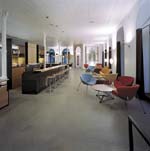 (Marc Cramer) Hôtel Gault. Design: YH2; Paul Bernier, architecte; Fournier, Gersovitz, Moss et associés architectes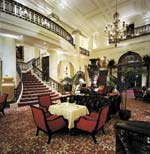 (Marc Cramer) Hôtel Le St-James. Design: Jacques Bouchard, designer d'intérieur; CDID Design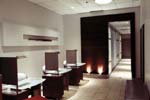 (Sébastien Raymond) Les Ongles de l'Île. Design: MVS Design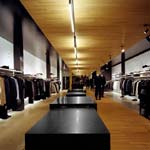 (Marc Cramer) Boutique Michel Brisson. Design: Saucier + Perrotte architectes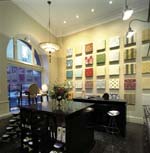 (Marc Cramer) Celadon. Design: Scott Yetman designer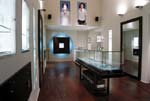 (-) Clio Blue. Design: Annie Lacaille designer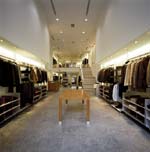 (Marc Cramer) Eccetera & co. Design: Krief Design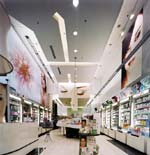 (Marc Cramer) Jean Coutu (cosmetics section). Design: Optima Design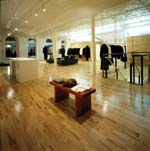 (Marc Cramer) Kamkyl Urban Atelier. Design: Jean-René Corbeil architecte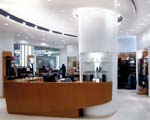 (Jean-Pierre Lamer) Lacoste. Design: Yelle Maillé, architectes associés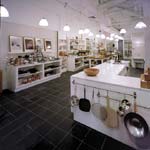 (Marc Cramer) Les Touilleurs. Design: Louise Savoie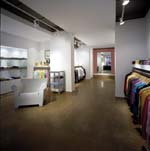 (Marc Cramer) Mimi & Coco. Design: Alex Farhoud designer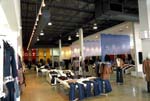 (-) OZOC. Design: Optima Design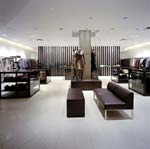 (Marc Cramer) Ports 1961. Design: Aedifica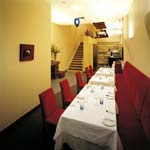 (Marc Cramer) Anise. Design: Jean-Pierre Viau Design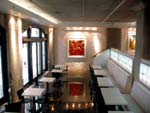 (-) Café Daylight Factory. Design: David Pouliot designer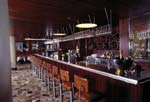 (Ted Romer) Leméac Café Bistro. Design: Luc Laporte architecte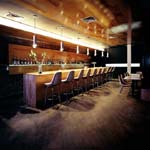 (Marc Cramer) Mile End Bar. Design: INPHO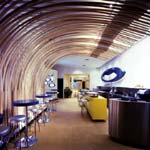 (Marc Cramer) Oasis Oxygène. Design: Foti Drouin designers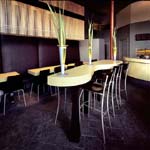 (Marc Cramer) Resto Le 2. Design: LDC |
© 2003 ArchNewsNow.com